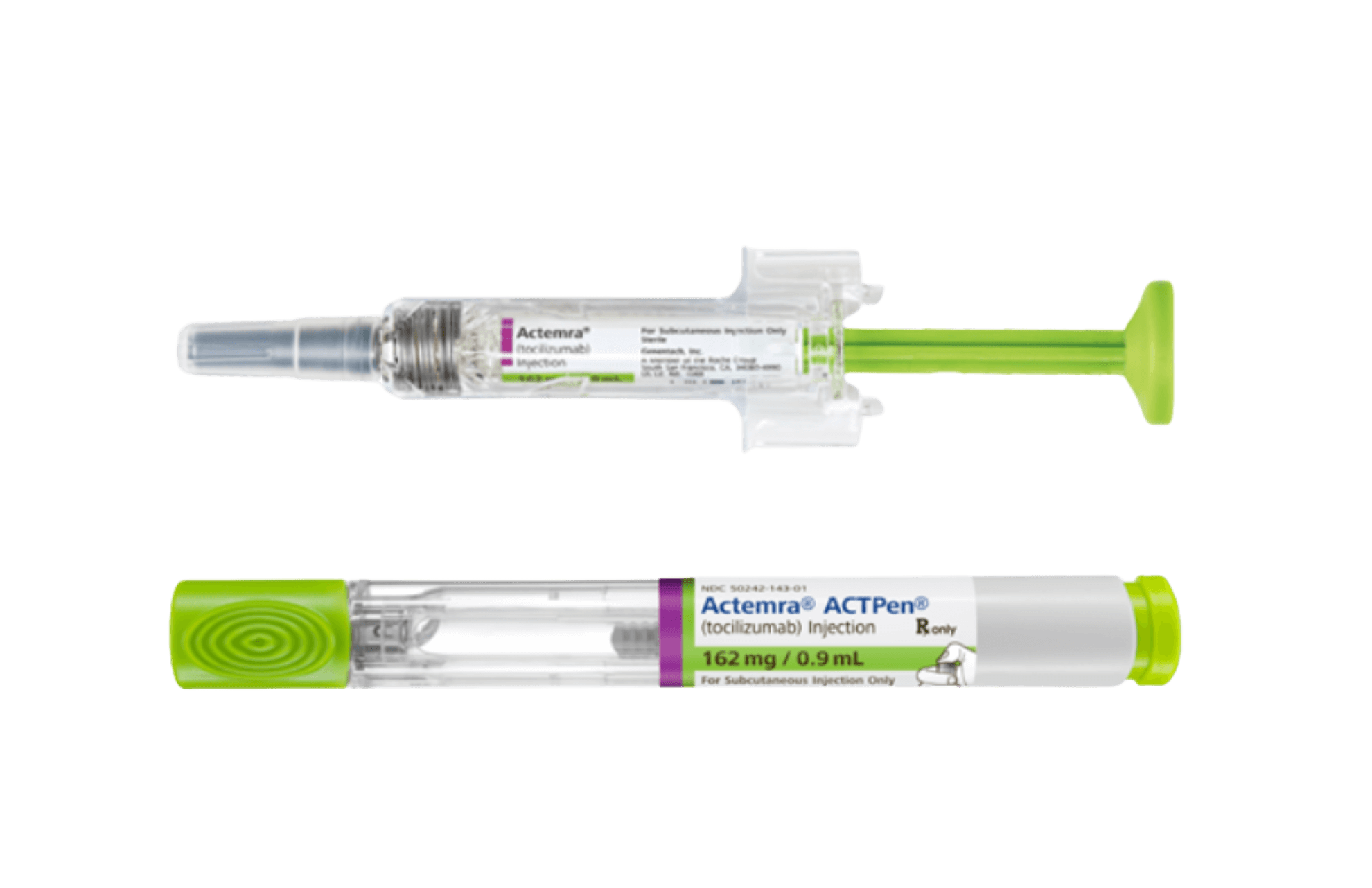Actemra (generic name: tocilizumab) is used to treat adults with active
moderate to severe rheumatoid arthritis (RA) after at least one other disease-modifying antirheumatic drug (DMARD) has failed to relieve the symptoms. Actemra has been shown to
slow the damage the disease causes to the cartilage and bone of affected joints and improve the patient’s ability to carry out normal daily activities.
Actemra is also prescribed for treating adults with
giant cell arteritis (GCA), which is caused by inflammation of the body’s largest arteries, especially those that supply blood to the head and neck.
Actemra can be prescribed either in combination with
methotrexate or as monotherapy to treat children over one year of age and adolescents who have
active systemic juvenile idiopathic arthritis and have not responded adequately to previous therapies with systemic corticosteroids or to non-steroidal anti-inflammatory drugs.
Actemracan be prescribed either in combination with methotrexate or as monotherapy to treat children over two years of age as well as adolescents with
polyarticular juvenile idiopathic arthritis who have not responded adequately to therapy with methotrexate on its own.
Tocilizumab is a medication known as an
interleukin-6 (IL-6) receptor antagonist, which means it blocks the metabolism of IL-6. IL-6 has a key role in the physiology of rheumatoid arthritis. It is found in high levels in the synovial fluid and serum of patients with RA and directly influences the levels of disease activity and joint destruction.
Actemra comes in two forms: either as a
prefilled syringe with a single-dose needle that is manually injected, or in the form of the ACTPen® Autoinjector, which is a prefilled, single-dose, pen-like autoinjector that shields the needle tip before the injection. It allows you to inject by pressing a button.
Dosage and mode of administration
Actemra is administered as a
subcutaneous injection and in most cases, patients self-administer the medication after receiving training from a healthcare professional. The dosing schedule can vary based on the conditions, but generally involves
scheduled injections, which provides a simple regime for people managing such a chronic inflammatory disease. It is important to
rotate injection sites to avoid skin irritation. If a dose is missed, the missed dose should be injected as soon as possible, then continue with their regular monthly schedule. However, if it is now is close to the next scheduled dose, the missed dose should be skipped. Do not double-dose to make up for a missed dose.
Cautions
If you are pregnant, think you are pregnant, or are planning to become pregnant, consult with your doctor. Women of child-bearing age must use
effective contraception during treatment and up to three months after treatment. If you fall pregnant while being treated with Actemra, consult with a doctor immediately. Women who going to breast-feed are usually advised to leave a gap of at least 3 months after the last treatment before starting to breast-feed. It is not known whether Actemra is secreted into breast milk.
Storage
Actemra should be stored in a refrigerator at temperatures between 36°-46°F (2°-8°C) and must not be frozen. Store the syringe or autoinjector in its original carton to protect it from light until the time of use.
Common Questions About Actemra
How is Actemra administered?
Actemra has to be administered as a subcutaneous injection, on a weekly, fortnightly or monthly schedule depending on the age of the patient and the condition being treated. Patients or caregivers are trained to perform the injections at home. It’s important to follow the dosing schedule prescribed by a healthcare provider.
Can tocilizumab be used during pregnancy or breastfeeding?
The effects of Actemra on pregnant or breastfeeding women have not been fully studied. Therefore, it’s essential to discuss potential risks and benefits with a healthcare provider before treatment begins, and for any woman of child-bearing age to take adequate contraceptive measures.
What is rheumatoid arthritis, and how does Actemra help?
Rheumatoid arthritis (RA) is an autoimmune disorder causing inflammation in the joints, leading to pain, swelling, and potential joint damage. Interleukin-6 (IL-6) receptor antagonists such as Actemra help reduce these symptoms and slow down progression of the disease.
This text is for informational purposes only. Please consult a doctor or pharmacist before using any medication.
Read the information leaflet that comes with the medication.
If a sudden allergic reaction (anaphylaxis) occurs after taking Actemra, with symptoms like swelling of the face, tongue, or throat making it difficult to breathe or swallow, or there is wheezing, hives, rash, blistering, or peeling of the skin, call a doctor or 911 right away, or go to an emergency room immediately.
Most people who use Actemra do not experience any adverse side effects. Doctors prescribe this medication because they assess the benefits of such treatment outweigh any likely unwanted effects.
Some of the side effects that have been reported include:
- Upper respiratory tract Infections, with symptoms including cough, nasal congestion, and sore throat.
- Injection site reactions such as redness, itching, pain, or swelling at the injection site.
- Pneumonia
- Shingles (herpes zoster)
- Cold sores (herpes of the lips), blisters
- Skin infection (cellulitis) sometimes with fever and chills
- Rash and itching, hives (urticaria)
- Allergic (hypersensitivity) reactions
- Eye infection (conjunctivitis)
- Headache, dizziness, high blood pressure
- Mouth ulceration, stomach pain
- Fluid retention (edema) in the lower legs, along with weight gain
- Coughing, shortness of breath
Not all side effects are listed here. If these or other unlisted symptoms persist or worsen, consult a healthcare provider or pharmacist.
Actemra is usually prescribed to treat inflammatory diseases that affect joints or blood vessels, often involving the immune system mistakenly attacking the body’s own tissues.
Rheumatoid arthritis (RA) mostly affects adults. The main symptoms are swelling, pain, and stiffness in multiple joints (often wrists, hands, and feet); morning stiffness lasting longer than 30 minutes; fatigue, low-grade fever, and general feeling of being unwell. Symptoms usually appear symmetrically (same joints on both sides of the body)
Giant Cell Arteritis (GCA) usually affects people over 50, and is more common in women that men. The main symptoms are persistent headache, often around the temples; scalp tenderness; jaw pain when chewing; vision problems, such as blurred vision or sudden vision loss; fever, fatigue, and weight loss.
Active Systemic Juvenile Idiopathic Arthritis (Systemic JIA) affects mostly children, typically under age 16. The main symptoms are daily fevers that spike once or twice a day; pink or salmon-colored rash that comes and goes; swelling and pain in one or more joints; fatigue, poor appetite, and weight loss; enlargement of the liver, spleen, or lymph nodes in some cases. Systemic JIA is unique among juvenile arthritis types because it affects the entire body, not just the joints.
Polyarticular Juvenile Idiopathic Arthritis (Polyarticular JIA) affects children, more often girls. The main symptoms are pain, swelling, and stiffness in five or more joints within the first six months, in both large and small joints (e.g., knees, wrists, fingers); morning stiffness or stiffness after rest; fatigue and sometimes low-grade fever. It resembles adult RA and may involve the immune system attacking joint linings, leading to chronic inflammation.
All of these conditions are serious and require diagnosis and treatment by healthcare professionals. Early treatment by medications such as Actemra can significantly improve outcomes, especially in preserving joint function and reducing complications.













